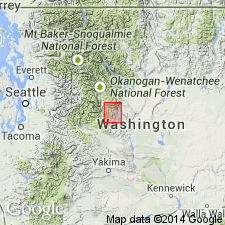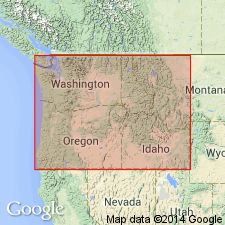
- Usage in publication:
-
- Wenatchee Formation*
- Modifications:
-
- Named
- Reference
- Geochronologic dating
- AAPG geologic province:
-
- Northern Cascade Range-Okanagan province
Summary:
Unit is named the Wenatchee Formation following the informal usage of Buza (1976) and Gresens (1977). Is exposed in the Chiwaukum graben in the eastern foothills of the central Cascade Range in WA. May be present below the Columbia Plateau basalt flows to the east; is absent to the west, due partly to erosion. Is divided into two members at the type section: a lower sandstone and shale member subdivided into lower shale-dominated fluvial beds, sandstone-dominated fluvial beds, and shale and sandstone beds of lacustrine origin; and an upper white conglomerate member. Unconformably overlies crystalline basement rocks of the Swakane Biotite Gneiss of the Chumstick Formation (new); unconformably underlies post-Miocene diamictite derived from the Yakima Basalt. Thickness at the type section is about 155 m; the maximum observed thickness is 300 m. Age is early Oligocene based on an age of 34 Ma (zircon) from tuff.
Source: US geologic names lexicon (USGS Bull. 1565, p. 350); GNU records (USGS DDS-6; Menlo GNULEX).

- Usage in publication:
-
- Wenatchee Formation*
- Modifications:
-
- Geochronologic dating
- AAPG geologic province:
-
- Northern Cascade Range-Okanagan province
Summary:
Pg. 13, geologic time scale (inside front cover). Wenatchee Formation. Three samples from altered crystal-vitric rhyolite ash-flow tuff, in Wenatchee 7.5-min quadrangle, Chelan and Douglas Counties, Washington, yielded fission-track ages on zircon 49.1 +/-4.6 Ma (too old), 34.5 +/-3.9 Ma, and 33.4 +/-3.2 Ma; and on apatite 39.8 +/-9.0 Ma. Age of tuff considered 33.4 +/-3.2 Ma. Data from Tabor and others, 1982 (USGS Misc. Geol. Inv. Map I-1311). Ages calculated using decay constants of Steiger and Jager, 1977 (Earth Planet. Sci. Letters, v. 36, p. 359-362). [Age considered late Eocene to early Oligocene; Eocene-Oligocene boundary 36.6 (38 to 34) Ma (from Geologic Names Committee, USGS, 1983 ed. geol. time scale, with additions from N.J. Snelling, 1985, The Geol. Soc. Mem., no. 10).]
Source: Publication.
For more information, please contact Nancy Stamm, Geologic Names Committee Secretary.
Asterisk (*) indicates published by U.S. Geological Survey authors.
"No current usage" (†) implies that a name has been abandoned or has fallen into disuse. Former usage and, if known, replacement name given in parentheses ( ).
Slash (/) indicates name conflicts with nomenclatural guidelines (CSN, 1933; ACSN, 1961, 1970; NACSN, 1983, 2005, 2021). May be explained within brackets ([ ]).

